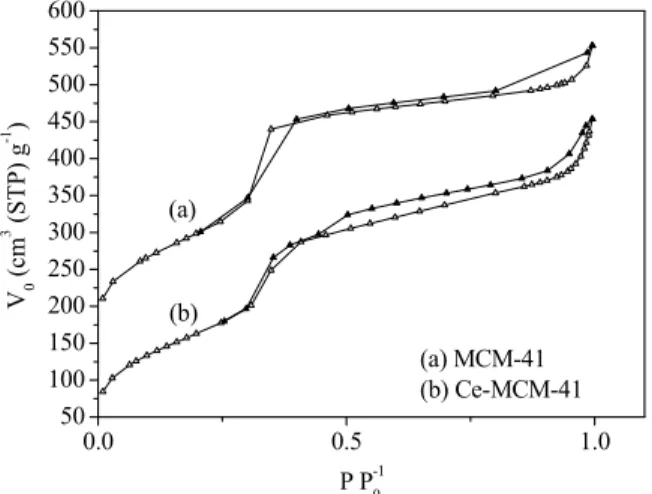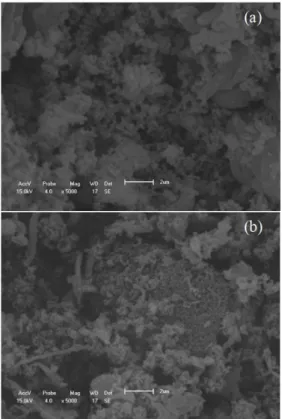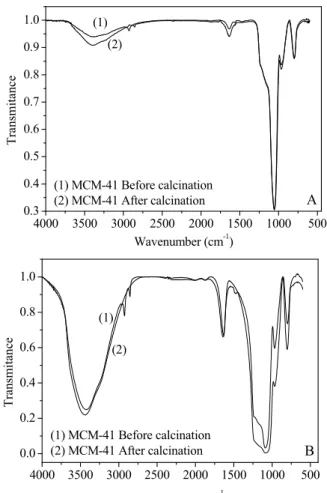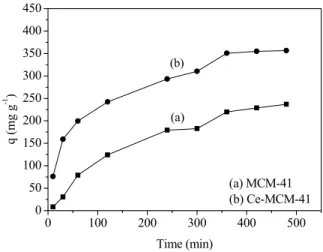ISSN 0104-6632 Printed in Brazil
www.abeq.org.br/bjche
Vol. 33, No. 03, pp. 541 - 547, July - September, 2016 dx.doi.org/10.1590/0104-6632.20160333s20150132
*To whom correspondence should be addressed
Brazilian Journal
of Chemical
Engineering
CERIUM INCORPORATED INTO A MESOPOROUS
MOLECULAR SIEVE (MCM-41)
G. E. do Nascimento
*, M. M. M. B. Duarte and C. M. B. M. Barbosa
Departamento de Engenharia Química, Universidade Federal de Pernambuco, Avenida Artur de Sá, s/n, 50740-521, Recife - PE, Brazil.
Fax: (55) (81) 2126-7278 E-mail: grazielen@yahoo.com.br
(Submitted: February 27, 2014 ; Revised: June 30, 2015 ; Accepted: July 9, 2015)
Abstract - The synthesis and characterization of a mesoporous molecular sieve (MCM-41) was studied due to its high surface area and large pore volume and to target potential applications in adsorption and catalysis. Ra-re earth elements have special chemical properties and aRa-re efficient promoters for supports. In this study, a mesoporous molecular sieve that incorporates the transition metal cerium (Ce-MCM-41) was synthesized us-ing the hydrothermal method with the goal of improvus-ing the structural properties for adsorption. The molar composition of the obtained gel was 1CTMABr: 4SiO2: 1Na2O: 0.2Ce2O3: 200H2O. The pure mesoporous
molecular sieve MCM-41 was also synthesized using the same method. The materials were characterized by the following techniques: XRD, BET/BJH, SEM/EDS, TG and FT-IR. A preliminary test to evaluate the mate-rials as adsorbents to remove naphthenic acids present in jet fuel was performed. The results of the characteri-zation showed that the incorporation of the metal cerium did not affect the MCM-41 structure and that mesporous materials were formed. Ce-MCM-41 exhibited good thermal stability, high specific surface area and large pore volume, which are characteristics of a good adsorbent. From the preliminary test, the adsorp-tive capacity increased by 60% with the incorporation of cerium in the MCM-41 structure.
Keywords: Mesoporous molecular sieves; Ce-MCM-41; Synthesis; Characterization.
INTRODUCTION
The mesoporous molecular sieve MCM-41, which is a member of the M41S family, was first dis-covered by the Mobil Company in 1992 to eliminate diffusion pore restrictions present in zeolites due to its micropores, which limit its use with larger mole-cules for adsorption and catalytic conversions (Beck et al., 1992; Corma et al., 1997).
Since then, much interest has been focused on their properties and applications due to the hexago-nal arrangement, their high specific surface areas, narrow pore size distribution and controllable and wide spectrum of pore diameters (15-100 Å) in the mesoporous region (Jiang et al., 2007; Zhao et al., 2011).
The mesoporous molecular sieves can be applied in areas of catalysis and adsorption, can control pol-lution in the environment (Hao et al., 2006; Qin et al., 2007; Puanngama and Unob, 2008) and can be used in technology that employs advanced materials based on molecular sieves, such as electron transfer photo-sensors, semiconductors, polymers, carbon fibers, clus-ters and materials with nonlinear optical properties (Beck et al., 1992; Corma et al., 1997; Northcott et al., 2010).
its synthesis, in which silicon is replaced with other ions. The incorporation of heteroatoms into MCM-41 walls allows one to control its features, which makes it possible to obtain materials with predeter-mined properties, such as surface acidity, redox properties, basicity and thermal stability (Oliveira et al., 2005; González Vargas et al., 2013).
Molecular sieves can generate more basic or acid sites as desired for the particular application (Li et al., 2010). These active sites are created by isomor-phous substitution of silicon by a metal with the goal of improving the adsorptive and catalytic applica-tions. The creation of basic sites on the surface of MCM-41 favors its affinity for acidic compounds, which improves its adsorption capacity. In recent decades, the incorporation of heteroatoms into the MCM-41 structure has been investigated (González Vargas et al., 2013; Li et al., 2013).
The incorporation of transition metals (Nilsen et al., 2007; Anunziata et al., 2008), rare earth metals (Zhao et al., 2011; Akondi et al., 2012) and alkaline earth metals (Wu et al., 2011; Nascimento et al., 2014) into MCM-41 produces new types of adsorbents.
The incorporation of rare earth metals into meso-porous silicates showed an improvement in their thermal stability and structural properties, such as pore volume and surface area, compared with that of pure MCM-41 (Chien et al., 2005).
Given the above discussion, the goal of this study was to investigate the mesoporous molecular sieve MCM-41 incorporating cerium through its synthesis and its characterization. This material can be used as an adsorbent to remove naphthenic acids present in jet fuel.
EXPERIMENTAL
Synthesis of Mesoporous Molecular Sieves MCM-41 and Ce-MCM-MCM-41
The mesoporous molecular sieve Ce-MCM-41 was synthesized using the hydrothermal method (Nascimento et al., 2014) with silica gel and sodium silicate as the silicon source, cetyltrimethylammonium bromide (CTMABr) as a structural director, cerium nitrate as a transition metal source and distilled wa-ter. The synthesis was conducted at 100 °C in a Teflon-jacketed stainless steel autoclave for a period of five days with a daily correction pH range of 9.5-10.0 with a 30% solution of acetic acid. The molar com-position of the gel obtained was 1CTMABr: 4SiO2:
1Na2O: 0.2Ce2O3: 200H2O. Then, the obtained
mate-rial was subjected to a calcination process using a heating ramp of 5 °C min-1, beginning from ambient temperature to 500 °C, in an inert atmosphere of ni-trogen at a flow rate of 100 mL min-1, which
re-mained in this condition for 1 hour. Then, the flow was exchanged with synthetic air at a rate of 100 mL min-1 for an additional period of 1 hour.
The pure mesoporous molecular sieve MCM-41 was also synthesized by the same method.
Characterization of Mesoporous Molecular Sieve MCM-41 and Ce-MCM-41
The characterization of the materials was per-formed using X-ray diffraction (XRD); N2
adsorp-tion/desorption by the BET and BJH method; scan-ning electron microscopy with energy dispersive spectroscopy (SEM/EDS); thermogravimetric analy-sis (TG) and Fourier transform infrared (FT-IR) spectroscopy.
X-ray diffraction measurements were performed on a BRUKER D8 ADVANCE diffractometer using Cu-Kα radiation. N2 adsorption and desorption were
obtained using an ASAP 2420 from MICROMERIT-ICS. The spectrum energy dispersive X-ray and elec-tron microscopy of the sample scan were obtained in an energy dispersive spectrometer coupled to a scan-ning electron microscope (Shimadzu Superscan SS-550) using 15 V. The TG curve was obtained in a thermobalance (NETZSCH STA 449 F3 Jupiter model) in an atmosphere of 100 mL min-1 of
nitro-gen. The absorption spectra in the infrared region were obtained with an infrared absorption spec-trometer VERTEX 70 of BRUKER using KBr as a dispersing agent.
Preliminary Test
n-Dodecanoic acid (C12H24O2) (99% purity,
Merck) was used as the model adsorbate to represent naphthenic acids and n-dodecane (C12H26) (99%
purity, Merck) as the solvent.
Brazilian Journal of Chemical Engineering Vol. 33, No. 03, pp. 541 - 547, July - September, 2016
RESULTS AND DISCUSSION
Characterization of Mesoporous Molecular Sieves MCM-41 and Ce-MCM-41
X-Ray Diffraction (XRD): Figure 1 shows the
X-ray diffractograms of the synthesized MCM-41 and Ce-MCM-41 samples after calcination.
0 2 4 6 8 10
0 20000 40000 60000 80000 100000 120000 140000
(b)
In
tensity
2
(a) MCM-41 (b) Ce-MCM-41
(a)
Figure 1: X-ray diffraction after calcination of
MCM-41 (a) and Ce-MCM-41 (b).
It can be observed from Figure 1 that the syn-thesized MCM-41 and Ce-MCM-41 materials showed an X-ray pattern similar to that shown in the literature for mesoporous materials (Beck et al., 1992).
The X-ray diffraction pattern of MCM-41 showed the presence of a strong diffraction peak (100) at 2θ = 2.17° and two low intensity peaks at (110) and (200) of 3.69° and 4.27°, which indicates the for-mation of orderly mesoporous material. The X-ray diffraction pattern of Ce-MCM-41 also showed the presence of these peaks at (100), (110) and (200) 2θ = 2.00°, 3.48° and 4.04°, respectively, which indi-cates that the structure of hexagonal MCM-41 was maintained after introducing cerium into its struc-ture. There was also a decrease in the relative inten-sity of the diffraction patterns of Ce-MCM-41 in comparison with MCM-41, which indicates the in-clusion of cerium according to Subhan et al. (2012), Bing et al. (2012; 2013) and Akondi et al. (2014).
The unit cell parameter (a0) was calculated using
the formula a0 = 2d100/√3, and the value of the
d-spacing (d100) was obtained from the XRD pattern
peak using the Bragg equation (2 d sinθ = λ, where
λ = 1.5406 for Cu-Kα). Table 1 shows these pa-rameters for the MCM-41 and Ce-MCM-41 materi-als after calcination.
Table 1: The cell parameters, pore diameter, pore volume, pore wall and surface area of MCM-41 and Ce-MCM-41.
Sample d100 (nm)
a0 (nm)
SBET (m2
g-1 )
Pore diameter
(nm)a Pore volume (cm3
g-1 )
Pore wall (nm)b MCM-41 4.07 4.70 908.7 3.96 0.84 0.74 Ce-MCM-41 4.41 5.09 756.8 4.43 0.76 0.66
aPore diameter obtained from BJH analysis of desorption data. bPore wall = a
0 – pore diameter.
Table 1 shows that the values of a0 and d100
in-creased after the incorporation of cerium, which is due to the substitution of Si4+ ions by Ce4+ ions, which are larger (Bing et al., 2012; González Vargas et al., 2013).
N2 adsorption/desorption by BET and BJH
method: N2 adsorptions/desorptions of MCM-41
and Ce-MCM-41 after calcinations are shown in Figure 2.
0.0 0.5 1.0
50 100 150 200 250 300 350 400 450 500 550 600
(b)
V0
(cm
3 (STP) g -1 )
P P-10
(a) MCM-41 (b) Ce-MCM-41 (a)
Figure 2: Isotherms of N2 adsorption/desorption of
MCM-41 (a) and Ce-MCM-41 (b) after calcination.
Δ Adsorption and ▲Desorption.
As shown in Figure 2 and based on the classifica-tion of the Internaclassifica-tional Union of Pure and Applied Chemistry (IUPAC), the isotherms of N2
adsorp-tion/desorption of both materials exhibited type IV behavior typical of mesoporous materials (IUPAC, 1982). The isotherms showed a sharp upturn in the relative pressure range of 0.3-0.4, which is due to capillary condensation of nitrogen into the pores (Akondi et al., 2014).
cerium in the channels of MCM-41. Also, there was an increase in the unit cell parameters and pore di-ameter, which can be attributed to the Ce atomic size (radius = 1.01 Å) being larger than that of Si (radius = 0.54 Å), which corroborates the XRD results. These results are consistent with reports of other authors (Chien et al., 2005; Bing et al., 2012, 2013; González Vargas et al., 2013; Akondi et al., 2014).
The MCM-41 and Ce-MCM-41 materials showed a high specific surface area and large pore volume, which is a prerequisite for their potential applications as adsorbents.
Scanning electron microscopy with energy
dis-persive spectroscopy (SEM/EDS): The electron
mi-crographic scans of the MCM-41 and Ce-MCM-41 materials that were calcined at 500 °C are shown in Figure 3.
Figure 3: MCM-41 (a) and Ce-MCM-41 (b)
micro-graphs.
From Figure 3, it can be observed that tubular grains were formed in both materials. The samples had hexagonal or spherical micelle-like edged rods. Similar micrographs were also obtained by Chien et al. (2005), Park et al. (2007), Akondi et al. (2012) and Bing et al. (2013).
The energy dispersive X-ray spectra of these ma-terials are shown in Figure 4.
The energy dispersive spectroscopy (EDS)
spec-tra of MCM-41 in Figure 4 show that the structure of the synthesized material was pure silica. The pres-ence of cerium was observed in Ce-MCM-41 be-cause the EDS spectrum contained a characteristic peak, which confirmed the presence of this element in the same mesoporous structure. Peaks due to sili-con appeared with higher intensity, followed by oxy-gen, which are constituents of the mesoporous mate-rial. In addition, peaks related to the presence of gold and carbon were observed due to the metallization process through which the sample passed.
Figure 4: MCM-41 (a) and Ce-MCM-41 (b) EDS
spectra.
Thermal analysis (TG): The curves from the
thermogravimetric analysis (TG) for the MCM-41 and Ce-MCM-41 samples that were not calcined are shown in Figure 5.
Brazilian Journal of Chemical Engineering Vol. 33, No. 03, pp. 541 - 547, July - September, 2016
and combustion of the organic director. After de-composition of the surfactant, the material continued to lose mass, which is related to water loss from the condensation of silanol groups at the inner surface of the pores with the driver interacting molecules. This region is in the range above 600 °C. These results were also observed by Zhao et al. (2011), who syn-thesized MCM-41 incorporating europium.
0 100 200 300 400 500 600 700 800 900
70 75 80 85 90 95 100 105
(a)
(a) MCM-41 (b) Ce-MCM-41
We
ight (%)
Temperature (°C) (b)
Figure 5: Thermogravimetric curves for MCM-41
(a) and Ce-MCM-41 (b).
Ce-MCM-41 exhibited a higher thermal stability with a residual weight of 92% at 900 °C, whereas MCM-41 had a residual weight of 70%. The modifi-cation of the MCM-41 silica framework with the rare earth metal caused an increase in the thermal stabil-ity of the material, which may improve its adsorption capacity.
Spectroscopy in the Fourier transform infra-red (FT-IR) region: Infrared spectra of Ce-MCM-41 before and after calcinations are shown in Figure 6.
The infrared spectra of the MCM-41 and Ce-MCM-41 samples before and after calcination showed bands in the region of 500-4000 cm-1, which are characteristic of the fundamental vibration of the MCM-41 network in accordance with the literature (Akondi et al., 2012).
The absorption bands at approximately 3400 cm-1
and 1650 cm-1 were observed in both the MCM-41 and Ce-MCM-41 materials, which correspond to stretching of the O-H bond of water and water ad-sorbed at the surface. Absorption bands at approxi-mately 1250, 1080 and 800 cm-1 refer to the
asym-metric and symasym-metric stretching of the Si-O-Si bond network. MCM-41 shows no vibration at 960 cm-1,
and a new band appeared at 970 cm-1 in the spectrum of Ce-MCM-41, which is attributed to the stretching of the bond Si-O-M (M = Ce). This result indicates the presence of cerium in the structure. These bands
were also observed by Park et al. (2007), Subhan et al. (2012), González Vargas et al. (2013) and Akondi et al. (2014) in their studies.
4000 3500 3000 2500 2000 1500 1000 500
0.3 0.4 0.5 0.6 0.7 0.8 0.9 1.0
(1) MCM-41 Before calcination (2) MCM-41 After calcination
(2) (1)
Tra
n
smitanc
e
Wavenumber (cm-1)
A
4000 3500 3000 2500 2000 1500 1000 500
0.0 0.2 0.4 0.6 0.8 1.0
Wavenumber (cm-1) (1) MCM-41 Before calcination (2) MCM-41 After calcination
T
ran
smita
nc
e
(2) (1)
B
Figure 6: FT-IR spectra of MCM-41(A) and
Ce-MCM-41(B) before (1) and after (2) calcination.
In both the MCM-41 and Ce-MCM-41 samples, the presence of the template could be confirmed by the bands in the 2800-2900 cm-1 region that are relat-ed to C-H stretching. After calcination, these bands of the directing agent disappeared, which indicates that the calcination process was effective in remov-ing such a compound, which was also observed by Park et al. (2007) and Nascimento et al. (2014). This result corroborates those found in the thermal analy-sis when there was mass loss due to the removal of the structure directing agent.
Both MCM-41 and Ce-MCM-41 materials showed functional groups that positively influence the ad-sorption of specific substances.
Preliminary Test
n-dodecanoic acid in n-dodecane when using the ad-sorbents MCM-41 and Ce-MCM-41, is presented in Figure 7.
0 100 200 300 400 500
0 50 100 150 200 250 300 350 400 450
(b)
q (mg g
-1 )
Time (min)
(a) MCM-41 (b) Ce-MCM-41 (a)
Figure 7: Preliminary test of naphthenic acid
ad-sorption by the adsorbents (a) MCM-41 and (b) Ce-MCM-41. Ratio = 0.01 (mass of adsorbent/solution volume) and agitation = 300 rpm.
It was observed that the incorporation of cerium into the MCM-41 structure promoted an average increase in the adsorptive capacity of approximately 60%.
These results highlight the importance of the in-corporation of the rare earth metal cerium into the mesoporous materials for obtaining a greater remov-al of naphthenic acids by adsorption.
CONCLUSION
The method of synthesis used to obtain the adsor-bent Ce-MCM-41 was effective because mesoporous material was formed, and the incorporation of cerium metal did not affect the structure of MCM-41, which was verified by the results obtained in the characteri-zation of the material. The material showed good thermal stability, high specific surface area and a large pore volume. The adsorbent showed technical potential to remove naphthenic acids present in jet fuel.
ACKNOWLEDGMENT
PRH-28, ANP, PETROBRÁS, UFPE and CETENE for analysis and characterization of the material.
REFERENCES
Akondi, A. M., Trivedia, R., Sreedhara, B., Kantam, M. L. and Bhargava, S., Cerium-containing MCM-41 catalyst for selective oxidative arene cross-dehydrogenative coupling reactions. Catal. Today, 198, 35 (2012).
Akondi, A. M., Kantam, M. L., Trivedi, R., Sreedhar, B., Buddana, S. K., Prakasham, R. S. and Bharga-va, S., Formation of benzoxanthenones and benzo-chromenones viacerium-impregnated-MCM-41 cat-alyzed, solvent-free, three-component reaction and their biological evaluation asanti-microbial agents. J. Mol. Catal. A: Chem., 386, 49 (2014).
Anunziata, O. A., Beltramone, A. R. and Cussa, J., Synthesis at atmospheric pressure and characteri-zation of highly ordered Al, V, and Ti-MCM-41 mesostructured catalysts. Catal. Today, 133, 891 (2008).
Beck, J. S., Vartuli, J. C., Roth, W. J., Leonowicz, M. E., Kresge, C. T. and Schmitt, K. D., A new family of mesoporous molecular sieves prepared with liquid cristal templates. J. Am. Chem. Soc., 114, 10834 (1992).
Bing, J., Li, L., Lan, B., Liao, G., Zeng, J., Zhang, Q. and Xukai Li, X., Synthesis of cerium-doped MCM-41 for ozonation of p-chlorobenzoic acid in aqueous solution. Appl. Catal. B - Environ., 115, 16 (2012).
Bing, J., Wang, X., Lan, B., Liao, G., Zhang, Q. and Li, L., Characterization and reactivity of cerium loaded MCM-41 for p-chlorobenzoic acid miner-alization with ozone. Sep. Purif. Technol., 118, 479 (2013).
Chien, S., Kuo, M. and Chen, C., Synthesis, charac-terization and catalysis of Ce-MCM-41. J. Chin. Chem. Soc., 52, 733 (2005).
Corma, A., Kan, Q., Navarro, M. T., Pariente, J. P. and Rey, F., Synthesis of MCM-41 with different pore diameters without addition of auxiliary or-ganics. Chem. Mat., 9, 2124 (1997).
González Vargas, O. A., De Los Reyes Heredia, J. A., Montesinos Castellanos, A., Chen, L. F. and Wang, J. A., Cerium incorporating into MCM-41 meso-porous materials for CO oxidation. Mater. Chem. Phys., 139, 125 (2013).
Hao, X.-Y., Zhang, Y.-Q., Wang, J.-W., Zhou, W., Zhang, C. and Liu, S., A novel approach to pre-pare MCM-41 supported CuO catalyst with high metal loading and dispersion. Microporous Mes-oporous Mater., 88, 38 (2006).
Brazilian Journal of Chemical Engineering Vol. 33, No. 03, pp. 541 - 547, July - September, 2016
Jiang, T. S., Zhao, Q. and Yin, H. B., Synthesis of highly stabilized mesoporous molecular sieves using natural clay as raw material. Appl. Clay Sci., 35, 155 (2007).
Li, D., Min, H., Jiang, X., Ran, X., Zou, L. and Fan, J., One-pot synthesis of Aluminum-containing or-dered mesoporous silica MCM-41 using coal fly ash for phosphate adsorption. J. Colloid Interface Sci., 404, 42 (2013).
Li, X., Li, B., Xu, J., Wang, Q., Pang, X., Gao, X., Zhou, Z. and Piao, J., Synthesis and characteriza-tion of Ln-ZSM-5/MCM-41 (Ln=La, Ce) by us-ing kaolin as raw material. Appl. Clay Sci., 50, 81 (2010).
Nascimento, G. E., Duarte, M. M. M. B., Schuler, A. R. P. and Barbosa, C. M. B. M., Synthesis, char-acterization, and application of the mesoporous molecular sieve Sr-MCM-41 in the removal of naphthenic acids from a model mixture of avia-tion kerosene by adsorpavia-tion. Brazilian Journal of Petroleum and Gas, 8(1), 1 (2014).
Nilsen, M. H., Antonakou, E., Bouzga, A., Lappas, A., Mathisen, K. and Stocker, M., Investigation of the effect of metal sites in Me–Al-MCM-41 (Me = Fe, Cu or Zn) on the catalytic behavior during the pyrolysis of wooden based biomass. Mi-croporous Mesoporous Mater., 105, 189 (2007). Northcott, K. A., Miyakawa, K., Oshima, S.,
Ko-matsu, Y., Perera, J. M. and Stevens, G. W., The adsorption of divalent metal cations on mesopo-rous silicate MCM-41. Chem. Eng. J., 157, 25 (2010).
Oliveira, A. C., Range, M. C., Fierro, J. L. G., Reyes, P. and Oportus, M., Efeito do Cromo nas Proprie-dades Catalíticas da MCM-41. Quim. Nova, 28, 37 (2005). (In Portuguese).
Park, S. H., Kim, B. H., Selvaraj, M. and Lee, T. G., Synthesis and characterization of mesoporous Ce-Mn-MCM-41 molecular sieves. J. Ind. Eng. Chem., 13, 637 (2007).
Puanngama, M. and Unob, F., Preparation and use of chemically modified MCM-41 and silica gel as selective adsorbents for Hg (II) ions. J. Hazard. Mater., 154, 578 (2008).
Qin, J., Li, B., Zhang, W., Lv, W., Han, C., Liu, J., Synthesis, characterization and catalytic perfor-mance of well-ordered mesoporous Ni-MCM-41 with high nickel content. Microporous Mesopo-rous Mater., 208, 181 (2015).
Qin, Q., Ma, J. and Liu, K., Adsorption of nitroben-zene from aqueous solution by MCM-41. J. Col-loid Interface Sci., 315, 80 (2007).
Subhan, F., Liu, B. S., Zhang, Y. and Li, X. G., High desulfurization characteristic of lanthanum loaded mesoporous MCM-41 sorbents for diesel fuel. Fuel Process Technol., 97, 71 (2012).
Wu, G., Jiang, S., Li, L. and Guan, N., Nitridation of BaO supported on mesoporous materials: Basicity characterization and catalytic properties. Appl. Catal., A, 391, 225 (2011).



